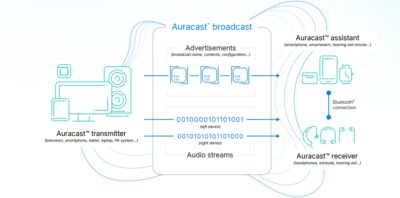Bluetooth Audio Technology Auracast TM, Induction and Other Technologies
Whether it’s an audio guide in a museum, public screening or announcements on a train platform, people with hearing impairments can benefit from additional transmission technology in many situations.
Eva Kohl

Platform announcements are difficult to understand even for people with normal hearing, especially near chatting or noisy passersby. Lectures in crowded event halls are similarly difficult to understand. Such situations are particularly challenging for people with moderate to severe hearing loss with conventional hearing aids or for people with only one-sided hearing.
That's why hearing system manufacturers developed different technologies to deliver speech closer to the ear virtually. Alongside infrared systems for private use and FM or Wi-Fi systems for closed groups, induction technology has proven particularly effective in public settings. Bluetooth has become an alternative for personal transmissions. Now Bluetooth Auracast™ is coming to the public domain, but also beyond.
Bluetooth – a versatile transmission technology
Bluetooth was developed in the 1990s for short-distance data transmission. The connection must be made actively on at least one side: we are talking about coupling or “pairing”. In the audio field, Bluetooth was soon used for speakers and headphones. Soon, hearing system manufacturers also developed additional devices to receive audio via Bluetooth – initially, the connection to the hearing system was used energy-saving short-range transmission or induction. For example:
- Siemens MiniTek, for Siemens hearing aids and SAMBA audio processors
- AudioLink (XT) for MED-EL Cochlear Implant Systems
- Artone 3 MAX with inductive sound transmission – for all hearing systems with inductive reception
Since the introduction of Bluetooth Low Energy, or BLE, hearing systems have been developed with built-in Bluetooth receivers, such as the SONNET 3, or with small plug-in receivers like the AudioStream.
BLE audio with Auracast™ is another extension of Bluetooth technology that is interesting beyond the use in hearing aids and is now slowly becoming available to customers. Auracast is particularly interesting for wireless audio broadcasting in public areas.

Cover photo ©Adobe Stock
A look into the future – Auracast™ lets users dream
Introduced at the beginning of 2022, the transmission with Auracast™ can best be compared with network broadcast: messages to all participants of a computer network – for example in a WLAN (Wi-Fi) network. The range of Auracast at 100 metres is also roughly equivalent to that of a WLAN transmission –and about ten times greater than conventional Bluetooth.
Many devices, such as smartphones, tablets, wireless microphones or smart TVs, can transmit Auracast signals – in stereo and with meta-data: as with satellite radio or the RDS radio data system. The receivers can include speakers, headphones, soundbars, or hearing systems. But you can also set up private transmissions and secure them with a PIN or password, much like a Wi-Fi network.
A station can broadcast several streams at the same time and the broadcasts of different stations can overlap. Users therefore need to select the desired Auracast network using an Auracast assistant — scrolling through available broadcasts as with a radio, selecting manually as with Wi-Fi, or by scanning a QR code. This selection can be made via an app, a smartwatch, a remote control, or directly on the receiving device.
 Auracast is taking time to roll out
Auracast is taking time to roll out
“Train stations, airports, and other public spaces with high background noise can be challenging environments for people with hearing loss,” said Eric Bernard in 2022 at the launch of Auracast. At the time, he was president of the European Hearing Instrument Manufacturers Association (EHIMA). The potential applications of Auracast appear almost limitless, including in relation to hearing devices: in addition to the situations mentioned by Bernard, it could also be used in cinemas or at public viewing events — even with multiple language options — or for guided tour systems. A one-to-one application, for instance at a ticket counter, would also be possible.
Bernard was confident at the time: “Over the past 50 years, hearing aid users have become accustomed to using the telecoil function to ensure better communication in churches and other public places where induction loops are installed. The new Auracast™ standard covers a much wider range of locations.”
In the meantime, the first hearing aids capable of receiving Auracast—or already prepared for it—are now available. However, users still report noticeable audio delays. 1 Until most hearing systems are equipped with faster Auracast processing, dedicated Auracast receivers such as the MoerDuo™ from MoerLab make reception possible: simply connect a neck loop to the MoerDuo™ audio output or to an equivalent device, and any hearing system with a T-mode becomes fully compatible with Bluetooth and Auracast.

Cover photo ©Adobe Stock
However, a broad introduction of Auracast transmitters is still a long way off in the industrialised countries. Induction systems have also taken decades to establish themselves, at least in part, in the public sector. As Auracast is also attractive to people with normal hearing, the increased consumer pressure could accelerate its introduction.
References
How CI users have heard better in public spaces so far
1. FM systems – which, strictly speaking, are no longer FM systems
In recent decades, FM systems have proven their worth especially in schools, at conferences and, in some cases, in the private setting. The term FM system comes from a time when analogue frequency modulation was used for wireless audio transmission.
Occasionally, the infrared systems, mainly used in the private settings, are also included. Today, however, digital near-field technologies are often used in the 2.4 gigahertz range. They offer better sound quality than classic FM systems. In addition to radio microphones, extensive device families also include options for transmitting the audio signal from other devices; they combine reception through hearing systems or headphones with external loudspeaker systems. In Austria, the Roger system from Phonak is widely used.
Thanks to channel selection, several audio signals can be offered in parallel: for example, different translations at a conference. However, FM systems are only partially suitable for public “streaming” because the transmitter and receiver must be compatible.
2. Audio transmission via wireless network
WLAN means “wireless LAN”, i.e. a wireless network. Internationally, the term WiFi is used for this purpose. It stands for “Wireless Fidelity” and is pronounced as: “Wai Fai”.
Wi-Fi is still relatively young when it comes to audio streaming: the audio signal is sent via Wi-Fi, the users log on to their personal mobile phone or tablet via Wi-Fi and receive the audio signal using a special app. They pass this on to their hearing aids or headphones usually via induction or Bluetooth. This is a high-quality solution for events, but has not been widely used so far. One of the few systems of this kind is the MobileConnect from Sennheiser.
3. Induction – the universal system for personal or spatial use
An alternating current in a conductor generates a magnetic field, and vice versa. The induction law, known to many from physics lessons, is the basis of the simplest and longstanding “streaming” system: induction.
Induction is standardised for hearing aids and is therefore widely compatible. The necessary receiver coil is integrated in many hearing systems or is available as an accessory. The commonly used terms “telecoil,” “T function,” and “MT function” are historically derived.
For personal use, neck loops are typically employed as transmitters. They connect to a mobile phone or audio device, in some cases wirelessly. Seat cushions with built-in induction coils are rare. For public streaming, entire rooms or specific areas are equipped with an induction loop — for example, in front of a ticket counter or inside a cinema.
Since the M or MT function also makes other electromagnetic signals audible, induction systems tend to produce interfering noise. Moreover, with this technology, only a single audio signal can be transmitted within one room. Nevertheless, induction remains the most universal transmission method, as it is the easiest for hearing systems to receive and process.






